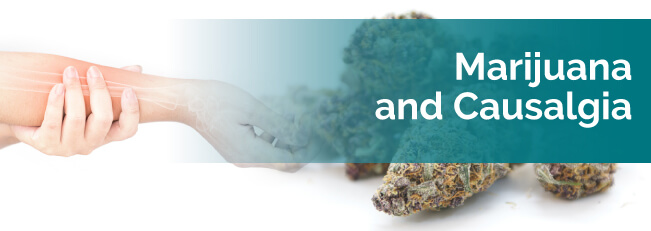
Causalgia used to be the name for complex regional pain syndrome type II, or CRPS II. This rare, painful and, at times, progressive condition affects you physically, mentally and emotionally. It’s characterized by burning pain, usually located in just one limb.
Medical cannabis can work to alleviate the symptoms of this painful condition. How? In this article, we’ll take a look at the relationship between cannabis and causalgia. We’ll also see what causes causalgia and its symptoms.
Causalgia is a rare and painful syndrome that relates to partial peripheral nerve injuries. Your peripheral nervous system is made up of nerves that stem from your spinal cord and brain’s central nervous system (CNS). These relate to your organs and limbs.
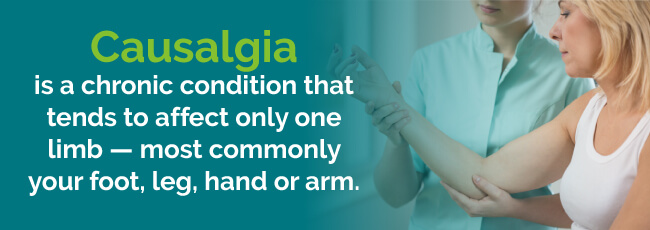
This chronic condition tends to affect only one limb — most commonly your foot, leg, hand or arm — and it’s usually brought on by sustaining an injury. Causalgia is believed to be caused by either malfunction of or damage to your central and peripheral nervous systems.
Causalgia is divided into two different types: CPRS-I and CRPS-II. If you don’t have a confirmed nerve injury, your condition is classified as the first type. In cases where you have a confirmed and associated nerve injury, you have type II, or causalgia.
Causalgia symptoms often vary in duration and severity. Some cases are mild and eventually disappear. In others, sufferers may not recover and are long-term disabled. Causalgia is most common in women, and children are rarely affected.
Although the initial cause of the condition is not known, it can often arise as a result of an overactive sympathetic nervous system. Upper extremities, in particular, one’s hands, are most commonly affected. Initial traumatic or painful events to the limbs or immobilization for long periods of time can also be causes for the condition.
The reason why one person may have it and not another is unclear. Common triggers are:
Causalgia is an abnormal response that magnifies the effects of an injury. The slightest stimuli can aggravate the condition or cause it to flare. The condition develops relatively soon after an injury, and patients explain the pain as intense.
The condition also affects your immune system. Elevated levels of cytokines (inflammatory chemicals) have been discovered in the tissues of individuals with the syndrome. These contribute to the warmth, redness and swelling reported by people suffering from causalgia. Interestingly, causalgia is more commonly found in people with already existing autoimmune and inflammatory conditions.
As reported by the Indian Journal of Plastic Surgery, causalgia was first documented by Ambroise Pare in the 16th-century as King Charles IX suffered from the condition. Later, in 1864, the father of American neurology, Silas Weir Mitchell, recorded the first detailed description. Mitchell discovered that there was an exaggerated presence of pain in injured American civil war veterans.
Mitchell came up with the term causalgia. It derives from the Greek for fire (kausis) and pain (algos).
If you feel you may have causalgia and want to know more about the symptoms to look out for, the following may help. Signs and symptoms include:
Symptoms vary from person to person and change over time. Initially, you can usually expect:
Over time, the affected limb often becomes cold and pale. You will also notice spasms, muscle tightening, skin and nail changes. When it gets to this stage, causalgia may be irreversible.
The symptoms often disappear on their own. For some, though, they last for months and even years. Causalgia can be worsened by emotional stress and sometimes spreads to other limbs. You may develop emotional issues from having to deal with the intense suffering that is so characteristic of severe causalgia.
It’s crucial to seek medical treatment as soon as you can if you think you are affected. Treatment is most effective when the syndrome is caught early.
Being in pain every day can dampen your mood. Long-lasting pain and discomfort causes you to withdraw from your usual daily activities and can lead to depression. Even carrying out mundane tasks, like washing the dishes or cooking a meal, can seem like an insurmountable task. Painkillers often don’t give you the relief you hope for, either, and if they do, there are side effects and the potential for addiction to consider.
Pain saps your spirit and drains your motivation, and it can make you feel like you’re alone. People around you cannot fully understand what you’re going through. They might eventually get tired of inviting you places as you never have the energy to accept the invitations. If you recognize yourself in these words, there is hope. Marijuana and causalgia can be a great match because medical pot is a natural way of alleviating causalgia symptoms.
If you’re wondering about the hard facts and statistics relating to causalgia, take note of these:
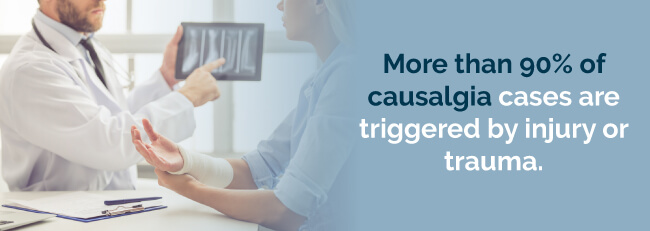
Treatment options that currently exist for this condition are biofeedback, acupuncture, forms of physical therapy, mirror box therapy, transcutaneous nerve stimulation, anti-anxiety medications and sympathetic nerve block.
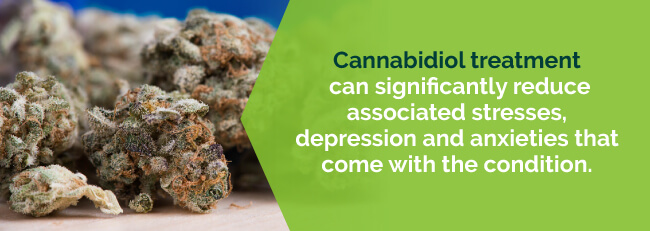
Cannabidiol treatment is particularly useful for treating causalgia because it can function to significantly reduce associated stresses, depression and anxieties that come with the condition. Additionally, it can work to assist patients in treating their chronic pain and reducing their inflammation.
There is no known cure for causalgia. Because of this, treatment goals are to relieve your painful symptoms.
There are various nonsurgical treatments available to relieve your pain. These include:
Many people, however, are concerned about the harmful side effects of the various medications available. Some worry about dependency and addiction to painkillers. There are also risks, such as heart and organ damage, to consider.
If you’ve been down the nonsurgical route and have had little or no relief from your symptoms, the following surgical treatments may help:
None of the above treatments come with a guarantee that they’ll give you complete relief from your symptoms. Perhaps this is why more people are turning to the medical pot world for answers to their causalgia pain relief questions.
A 2013 paper published by The American Pain Society stated that vaporized cannabis enabled causalgia sufferers to function more normally as well as enjoy a marked decrease in pain. In fact, causalgia is a qualifying condition for medical marijuana in both Illinois and Connecticut.
Medical cannabis for causalgia can help you return to your usual daily routine and social functioning. Find out more by talking to an experienced budtender or medical pot doctor today.
Medical pot is known to be a helpful treatment for causalgia, and it doesn’t produce any negative psychoactive side effects. Strains that are high in CBD can be used for relaxing muscle spasms, reducing stiffness and inflammation of your joints and for treating intense nerve pain. Cannabis is also useful for treating insomnia and anxiety.
Let’s take a look at some of the best strains of pot to use to alleviate your causalgia symptoms.
We’ve put together a quick starter’s guide to illustrate the benefits of medical marijuana for causalgia symptoms:
Chronic pain is arguably the most debilitating causalgia symptom you need to manage. No one likely wants to take painkillers for any protracted period. With this in mind, medical marijuana is a natural and gentle method of treatment. Some beneficial strains for minimizing pain and inflammation are:
When you don’t get adequate sleep, you feel tired, irritable and unable to cope with day-to-day living. Getting a good night’s rest is particularly crucial when you’re suffering from a chronic illness like causalgia. You need to be as kind to yourself as possible to give your body the best chance of healing. These two heavy indica strains are perfect for you if you lay awake tossing and turning each night:
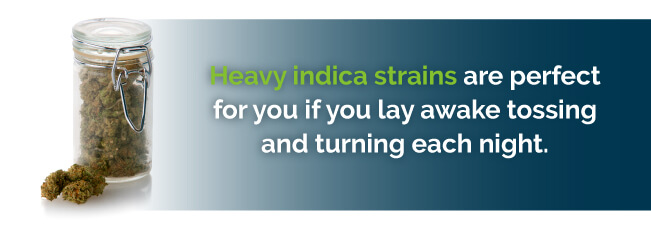
Depression brings you down even further when you’re battling chronic illness. Cannabis is the natural alternative if you don’t want to take a cocktail of drugs to treat your symptoms. Helpful strains for elevating your mood include:
Muscle spasms can be infuriating and uncomfortable. They’re also embarrassing and tend to make you feel self- conscious. These two strains are powerful treatments for this symptom:
Medical marijuana treats a whole host of symptoms. Many strains work on various levels and address many different issues. This is by no means an exhaustive list of potential treatments, but it should be enough to get you started. Furthermore, it provides you with an idea of just how powerful pot can be when it’s used for the right reasons.
Now that you know about some of the best strains of medical marijuana for relieving your symptoms, you need to know how to take it. Pot can be taken in various ways, including:
Considering all these many routes of ingestion of medical cannabis for causalgia, there’s sure to be a method that suits your needs. Taking medical pot doesn’t need to mean smoking joints. There are so many less obvious ways of taking your medication whenever you need to.
So, now you know more about medical marijuana for causalgia and how it can benefit you, it’s time to take that next step now and search for a medical marijuana doctor or dispensary today. Get back into the driver’s seat of your health and your life.
Looking for more information about CRPS I, CRPS II, Causalgia, or Reflex Sympathetic Dystrophy? Check out our additional resources below:
Find A Doctor Find A Dispensary